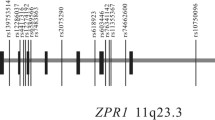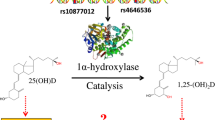Abstract
Objective
To explore susceptibility genes associated with yang-deficiency constitution using single nucleotide polymorphism (SNP) genotyping.
Methods
Based on an epidemiological survey, 30 volunteers with yang-deficiency constitution and 30 volunteers with a balanced constitution were included according to the Classification and Determination Standards of Constitutions in Traditional Chinese Medicine. Peripheral blood was collected and DNA was extracted from white blood cells. A genome-wide association study (GWAS) was conducted by SNP 6.0 genotyping at the Beijing CapitalBio Corporation Ltd. A minimum association P-value (Fisher’s exact value) of less than 10-4 in the allele, genotype, dominant, and recessive models served as the standard for significant association of SNP with yang-deficiency constitution.
Results
Among the four genetic models, a total of 42 SNPs were significantly associated with yang-deficiency constitution (Fisher’s exact P-values P<10-4). These SNPs were adjacent to more than 20 genes, including RGS6, mGluR5, GAPDHL19, and IKZF1.
Conclusion
Yang-deficiency constitution exhibits the characteristics of polygenic inheritance. This pilot study suggests that the polymorphisms in RGS6, mGluR5, GAPDHL19, and IKZF1 are associated with changes in cyclic adenosine monophosphate and cyclic guanosine monophosphate levels, memory, metabolic energy status, and immune function, respectively in people with yang-deficiency constitution.
Similar content being viewed by others
References
Yao SL, Wang Q. Discussion of the cause of yang-qi deficiency constitution. Chin J Basic Med Tradit Chin Med (Chin) 2008;14:405–407.
Yao SL. Study on theory of yang-qi deficiency constitution and gene expression profile of its peripheral blood. Beijing: Beijing University of Chinese Medicine; 2007:55–79.
Yang F, Zhao WL. Application of SNP-arrays in hematological malignancies. J Exp Hematol (Chin) 2009;17:496–499.
Mao X, Young BD, Lu YJ. The application of single nucleotide polymorphism microarrays in cancer research. Curr Genomics 2007;8:19–28.
Wang Q, Yao SL. Molecular basis for cold-intolerant yangdeficient constitution of traditional Chinese medicine. Am J Chin Med 2008;36:827–834.
Yao SL, Zhang ZZ, Yang XS, Xu X, Cao J, Xie GY, et al. Analysis of composite traditional Chinese medicine constitution: an investigation of 974 volunteers. J Chin Integr Med (Chin) 2012;10:508–515.
Xiong L.Study on qi-stagnation constitution and its distribution in Taibei City, Taiwang Province, China. Beijing: Beijing University of Chinese Medicine; 2007: Appendix II.
China Association of Chinese Medicine. Classification and determination of constitution in traditional Chinese medicine. Beijing: China Press of Traditional Chinese Medicine; 2009:1-10.
Mei MF. Conceiving yin and yang: harmony and you. Chin J Integr Med 2011;17:650–654.
Lu M, Yan SL, Ding WJ, Wang MQ, Li WH, Wu B. Relationship between familial cold syndrome of Kidney-yang deficiency and metablism of sugars, proteins and fats. Modern J Integr Tradit Chin West Med (Chin) 2005;14:701–702,715.
Mou Xin, Liu WH, Zhou DY, Liu YH, Hu YB, Ma GL, et al. Association of Chinese medicine constitution susceptibility to diabetic nephropathy and transforming growth factor-ß1 (T869C) gene polymorphism. Chin J Integr Med 2011;17:680–684.
GAO JL, LI QN. Regulation of bone formation via cAMP, cGMP signaling pathways. Chin Pharmacol Bull (Chin) 2010;26:1545–1549.
Furman B, Ong WK, Pyne NJ. Cyclic AMP signaling in pancreatic islets. Adv Exp Med Biol 2010;654:281–304.
Kirschner LS, Yin Z, Jones GN, Mahoney E. Mouse models of altered protein kinase A signaling. Endocr Relat Cancer 2009;16:773–793.
Sethakorn N, Yau DM, Dulin NO. Non-canonical functions of RGS proteins. Cell Signal 2010;22:1274–1281.
Wang L. Review on the research progress in regulators of G-protein signaling. J Southwest Univ Natl (Nat Sci ed, Chin) 2009;35:268–272.
Sibbel SP, Talbert ME, Sibbel SP, Talbert ME, Bowden DW, Haffner SM, et al. RGS6 variants are associated with dietary fat intake in Hispanics: the IRAS family study. Obesity (Silver Spring) 2011;19:1433–1438.
Li DT, Tian JY, Wang SH, Luan H. Review and prospect of inherent essence study on yang deficiency. Modern J Integr Tradit Chin West Med (Chin) 2000;9:1213–1215.
Zhu XH, Shen L, Wang SG. Study on the change of cyclic nucleotide in mice with yang vacuity disease. Labeled Immunoassay Clin Med (Chin) 2002;9:214–215.
Wang Q, Yao SL, Dong J, Wu HD, Wu CY, Xia ZY, et al. Changes of endocrine and immune function in subjects of yang deficiency constitution. J Integr Med (Chin) 2008;6:1227–1232.
Wang Q, Ren XJ, Yao SL, Wu HD. Clinical observation on the endocrinal and immune functions in subjects with yindeficiency constitution. Chin J Integr Med 2010;16:28–32.
Wang XL, Lv PY. Research advance of metabotropic glutamate receptors in learning and memory molecule mechanism. Med Recapitulate (Chin) 2008;14:1150–1152.
Lei Y. Discussion on psychological features of music memorizing and imagining. J Jianghan Univ (Humanities Sci, Chin) 2006;25(4):110–112.
Liu GQ, Bai yinbaoligao, Xing YQ. Advances in research on pseudogenes. Prog Biochem Biophys (Chin) 2010;37:1165–1174.
Olivero S, Maroc C, Beillard E, Gabert J, Nietfeld W, Chabannon C, et al. Detection of different Ikaros isoforms in human leukaemias using real-time quantitative polymerase chain reaction. Br J Haematol 2000;110:826–30.
Liu YS. ETS1 and IKZF1 are associated with clinical features of systemic lupus erythematosus in Chinese Han population. Hefei: Anhui Medical University; 2010:41–42.
Author information
Authors and Affiliations
Corresponding author
Additional information
Supported by the National Natural Science Foundation of China (No. 81072715)
Rights and permissions
About this article
Cite this article
Yao, Sl., Wang, Q., Zhang, Zz. et al. Genome-wide association study on susceptibility genes associated with yang-deficiency constitution: A small sample case-control study. Chin. J. Integr. Med. 21, 601–609 (2015). https://doi.org/10.1007/s11655-014-1957-5
Received:
Published:
Issue Date:
DOI: https://doi.org/10.1007/s11655-014-1957-5




